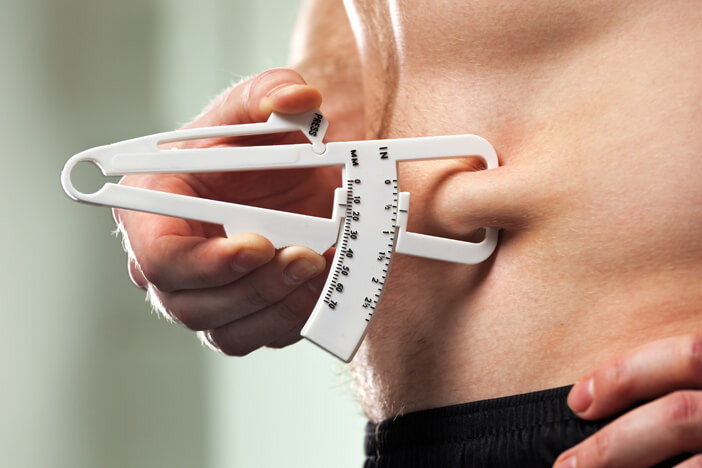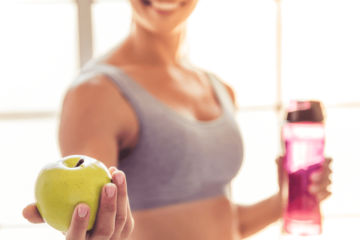Less body fat - How to reduce and measure your body fat

Do you regularly play sports – whether in the gym, jogging or cycling – but despite all your effort, your muscles don’t come into their own? Are the last few pounds of body fat covering your trained six pack? Do your legs looks a little less firm? Reducing your body fat is unavoidable if you want better defined muscles.
In this article, we will show you exactly what your body fat consists of, how it is produced and the most effective way it can be reduced.
What is body fat?
In order to lower your body fat, you should first know what body fat actually is and how it is produced.
There are three different types of body fat:
- white fat
- brown fat
- beige fat
These fulfill a variety of functions in your body:
- They control your metabolism
- They store energy
- They protect against external influences
- They provide thermal insulation
- They generate heat
When we talk about body fat reduction, we mean the white fat tissue, i.e. adipose tissue. This must be distinguished from the other two types of fat (brown and beige), because they are different tissues. In our bodies, white body fat has a very different function than the brown and beige body fat, which share similar functions.
However, all three types of body fat must be distinguished from free fatty acids and dietary fats. When we talk about body fat, we mean cells in our body. Fats that we obtain from food are energy suppliers and building materials that are used in our body.
White fat
White fat makes up by far the largest proportion of adipose tissue in our body. It is distributed over the connective tissue of our entire body, whereby it appears increased in some places for specific purposes. Although white fat is supplied with blood, it is not very metabolically active.
Fat itself consumes a negligible amount of energy as it does not do much.
Nevertheless, white fat fulfills a few important tasks in the body:
- Energy storage
- Hot and cold insulation
- Cushioning
- Hormone release
- Reservoir for fat-soluble substances
Most of our adipose tissue is located as subcutaneous fat tissue between our muscles and skin. Connective tissue ensures that the skin sits firmly on the soft fat layer. The connective tissue differs slightly between men and women, which is one of the main reasons why men are much less likely to suffer from cellulite than women.
Brown fat
For a long time, a distinction was only made between white and brown adipose tissue. Brown fat is most important for babies and recedes over time.
The primary function of brown fat is thermogenesis, i.e. the generation of heat.
It does this by burning fat in the mitochondria. The brown adipose tissue is therefore metabolically active and burns fat.
Appropriate to its function, the brown adipose tissue reacts primarily to a cold stimulus. In adult humans, brown adipose tissue no longer plays a specific role, as a smaller surface to volume ratio and the ability to shiver take over the tasks of temperature regulation. However, researchers suspect that certain stimuli could cause white fat to be converted into brown fat, as is the case in rodents. This has not yet been confirmed, but perhaps it is worth having a look the cold therapy of ‘Iceman’ Wim Hof to burn a little more fat.
Beige fat
It is a relatively recent finding that white adipose tissue in adults is also interspersed with other types of fat. It was not until 2012 that researchers identified the newly discovered fat cells as beige adipose tissue.
Beige fat is an intermediate form of white and brown fat.
Beige fat can also generate heat by burning fat, but is however far less effective than brown fat in babies.
How is body fat produced?

To be precise, we would have to ask how white storage fat is produced. The other parts of the white adipose tissue, which are used for insulation and cushioning, are not the problem when we talk about losing and gaining weight. This includes brown and beige fat.
The exact biochemical process, the long term results of which are jokingly referred to as ‘bingo wings’ or ‘spare tyres’, is a complex reaction that we would like to simplify and shorten for you here.
Simply put: The body stores excess energy (when we consume more calories than we need) in fat cells. When all of these cells are full, new fat cells are formed.
Find out here how to calculate your ideal calorie requirement and just let our free calorie calculator do it for you.
To be more precise: Adipose tissue, i.e. fat cells (adipocytes), are formed from stem cells. These cells can now absorb and release lipids – mostly triglycerides. The cell nucleus is very small. The stored fat droplets take up most of the cell.
Triglycerides are very energy rich compounds, can be stored without the aid of water and can quickly be made useable again, making them the ideal medium for storage. If too little energy is available, the body can quickly access these stores. If too much is available, it is conveniently stored in the adipose tissue with the help of triglycerides.
When all the current energy stores are full but there is still more energy to store, new fat cells can be created, which in turn can absorb more triglycerides. Triglycerides are considered chemical compounds, consisting of carbon, hydrogen and oxygen, which the body then has to assemble from raw materials. It does this especially when there is a surplus of both energy and carbohydrates.
So as a rule, when we gain fat, either pre-existing energy storage cells are filled or new storage cells are created and then filled. Conversly, when reducing body fat, the stores are emptied, but no fat cells are broken down.
Overweight - Why you should reduce your body fat

As you may have guessed from the title, there is a connection between body fat percentage and being overweight. The equation is simple:
If you are overweight, you probably have a high body fat percentage.
On the other hand, having a low weight does not automatically mean that you have a low body fat percentage.
For example, let’s take a 5″9 man who weighs 75kg. No one would say that this man is overweight, yet he may have an unhealthily high level of body fat because he does not exercise enough and eats an unhealthy diet.
In this case, he has a very low percentage of muscle mass and, conversely, an increased body fat percentage. With his height to weight ratio, this is very easily concealed with clothing and gives a false impression. A high percentage of body fat is already a risk factor for slim people (called ‘skinny fat’), but this is even more so for people who are overweight.
In this calculation, we can omit the small proportion of people who are nominally overweight, but who have a low body fat percentage and a high muscle mass. A critical glance is enough to see that, this is not someone who is an unhealthy weight.
As a guide, we have a table of recommended body fat percentages. How much body fat is normal? Should you reduce your body fat?
| Women | Men | |
|---|---|---|
| Essential body fat | 10-13% | 2-5% |
| Athletes | 14-20% | 6-13% |
| Average | 25-30% | 18-24% |
| Overweight | 32%+ | 25%+ |
Would you like to know more? Take a look at our article about ideal weight.
How much body fat is normal, too much, or not enough?
Of course it is difficult to separate the question of the right amount from the question of the individual aesthetic ideal. Nevertheless, there are ranges of body fat that can be a danger to your health and therefore represent a risk:
Men: You should only permanently fall below a body fat level of 5% if regular health checks are positive.
Women: You should be careful with values under 10%. The essential fat in our bodies fulfills important tasks and should not be the victim of supposed body optimisation.
In the upper range a fairly precise limit can be identified:
Increased risk of cardiovascular disease:
- Men: from 18% body fat
- Women: from 30% body fat
The fat around the abdomen in particular increases the likelihood of developing cancer or Type 2 diabetes. The statistical limits lie at:
- 102cm waist circumference in men
- and 88cm waist circumference in women
Whether you find a little more body fat attractive, like the ‘Dad bod’ celebrated in social media, or whether you would rather work towards a more defined body, the healthy range is between 5% and 18% for men and between 10% and 30% for women.
Why too much body fat is bad
You have already learnt from the previous text that too much body fat leads to various health problems:
-
- A heavy strain also puts weight on the passive musculoskeletal system, i.e. bones and joints, especially the spine, and leads to more frequent problems.
- Even the average life expectancy decreases significantly with increased weight and body fat.
- Another aspect is the adipose tissue itself. Whereas largely normal adipose tissue is also present in someone who has a healthy body fat percentage, the expansion of fat stores also means that more and more pro-inflammatory molecules are stored in the spaces between the tissues.
- This puts a high strain on our immune system.
- It has negative effects on hormone balance. Our hormones and neurotransmitters react to certain physical conditions, such as food shortages and surpluses, but also inflammations, injuries, and much more.
It is therefore very important to avoid excess fats, or if they are already there, to reduce them, through a healthy diet and lots of exercise.
Find out more about being overweight and the risks involved here.
Does reducing body fat help against cellulite?
There are three factors that have a direct influence on cellulite. Two of these you can influence directly through sport and nutrition.
A question commonly asked in relation to the reduction of body fat is whether reducing body fat also works well against cellulite. In this case, we will give a short answer: yes. There is however a difference between men and women. The male connective tissue between muscle and skin, which includes fat, tends to form a net, whereas the female connective tissue consists of inividual strands and tends to build chambers. When the fat cells in these chambers fill up, they expand upwards and the characteristic indents appear. Incidentally, the same effect occurs when the amount of body fat remains constant, but due to a lack of exercise there is less muscle to hold the connective tissue.
When it comes to cellulite, there is always a lot of talk about connective tissue and the collagen fibres that it is made of. However, you can hardly influence this factor, or more specifically, improving your connective tissue has no real influence on cellulite. What does have a big influence, however, is the amount of fat and muscle you have in that area. In short: building muscle (to give the connective tissue more support) und reducing fat are the two most effective ways to fight cellulite.
Want to get rid of cellulite? Find out everything about cellulite in this article.
How can you measure body fat / the reduction of body fat?

When measuring body fat percentage, the following applies: the more accurate you want the result to be, the more complicated and expensive it will be to measure.
Hydrostatic weighing or DEXA scan - The expensive and complicated methods
The most accurate measurements can be acheived through hydrostatic weighing and the so called DEXA scan. Both are mothods that you cannot perfom independently and that require complex equipment.
Hydrostatic weighing: For this method, you will be measured in a water bath. This method of measuring makes use of the various densities of individual tissue components (simply put: ‘fat floats’) and the displacement, i.e. your residual weight, will be measured.
DEXA Scan: This is a dual x-ray system that uses an optical procedure to show you how you fat is distributed.
Bioimpedance scales, Calliper and Co. - The cheap and accurate methods
If you don’t need ultra-precise measurements (let’s face it, no one does), it is better to measure with a bioimpedence scale, a caliper, with ultrasound or a tape measure.
Bioimpedence scale: When measuring on a body composition analyser, electricity is sent through your body and uses resistance to determine the composition of your body. Because electric currents always take the shortest route, it is recommended to use a scale with electrodes on your feet and hands. If you only have electrodes on your feet, the electric current will flow up one leg and down the other, meaning that you ultimately only measure your legs. Another problem with the scale is that your water balance has a strong influence on the measurements. Therefore you should always measure at a similar time each day and before physical activity in order to get comparable results that are sufficiently accurate.
Calliper & Ultrasound: Taking measurements using a calliper and ultrasound are very similar. Both methods involve directly measuring fat on various parts of the body and then calculating the value of body fat using a formula. There are formulas for up to 13 measuring points, which give very accurate results. In addition, these methods have the advantage that individual points on the body can be directly measured so that the distribution of fat can be seen. Ultrasound devices measure optically, whereas to measure with callipers, you pinch some fat and pull it away from the muscle. Both methods should be carried out by someone else, as some measuring points are difficult to reach yourself, and the angle of measurement can influence the results.
The more points you measure, the more accurate the results.
The Navy Method - The quick 'n dirty approach
To calculate your body fat with the so-called Navy Method, you only need a tape measure. You measure the circumference at three points on your body (sometimes two depending on the formula) and enter the results along with some other data into a calculator, which spits out a body fat value. The margin for error with this system is relatively obvious and you should not expect a particularly precise measurement, but if you measure every morning after you wake up, you will be able to track your own progress well. However you are less able to compare values with other peoples’ than with other methods.
Reducing body fat: this is how it's done!

The interaction between energy absorption through food and energy consumption through activity in the organs is called energy balance. You have probably encountered this already in some of our other texts and if not, you are bound to in the future.
The interaction between energy absorption through food and energy consumption through activity in the organs is called energy balance. You have probably encountered this already in some of our other texts and if not, you are bound to in the future.
An important step towards reducing body fat is having a negative energy balance, i.e. simply using up more energy than you take in. For this you need to know firstly how much energy you are taking in and secondly how much you are consuming. The best way to calculate your energy consumption is with our free calorie calculator.
You can find out how much you are taking in by counting calories: start by documenting everything you eat and drink. With our nutrition diary you can record food that you eat, your mood and your successes. This will take some work at first, but is a good way to find out your calorie intake and eventually bring it into a deficit, which is necessary to reduce body fat percentage.
Another very simple tool is the scale. If you find that you have gained one kilogramm in the past month without having played sport or having improved your performance, this means that over the month, you have taken in a surplus of about 7000kcal, which is the amount that your body needs to store a kilo of fat. If you find out that you have taken in too many calories, you have two options:
- Reduce nutritional energy (calories)
- Use up more energy (play sport)
Both of these mothods combined result in the easiest and, since time immemorial, most reliable way to reduce body fat. Forget additives like Fatburner – these acheive only a fraction of what a reduced, healthy diet and exercise can do. It is immediately evident from the word ‘healthy’ that it matters what you eat. Especially when it is not about weight reduction but body fat reduction: you should allow your body an adequate amount of protein in order to maintain muscle mass and avoid foods with high energy densities. Carbohydrates should also be eaten in moderation, and unhealthy carbohydrates should be avoided.
Don’t feel like counting calories or comparing and calculating food in order to reduce your body fat? Then try a diet plan by Upfit. With a plan for defition or weight loss it is easy to lose weight without having to do calculations – we do that part for you.
Body fat reduction is a marathon, not a sprint!

Reducing body fat is not something that can be done overnight. Therefore, last but not least, we would like to give you the most important thing to take away from this: patience and motivation.
Most people massively overestimate what they can achieve in a month and then quickly give up. On the other hand, most people underestimate what they can achieve in a year when they resolutely change their habits and attitude to eating, and therefore, they lack motivation. Those who consistently and continuously work on themselves will quickly feel better, will integrate changes into their daily lives and and can ultimately enjoy great results. Those who “just want to quickly lose a few kilos” will fall back into old patterns just as fast. Our motivational guide offers valuable tips on the best way to approach the topic of reducing body fat and motivating yourself in the long term.
On that note: get stuck in!
Sources
- J. Fanghänel et al. (2003): Waldeyer Anatomie des Menschen (17. Aufl.). Verlag Walter de Gruyter, Berlin.
- J. Schwegler, R. Lucius (2016): Der Mensch – Anatomie und Physiologie (6. Aufl.). Thieme Verlag, Stuttgart.
- S. Iliodromiti et al. (2018): The impact of confounding on the associations of different adiposity measures with the incidence of cardiovascular disease: a cohort study of 296 535 adults of white European descent. European Heart Journal (39), S. 1514-1520.
- J. Wu, P. Boström et al. (2012): Beige Adipocytes Are a Distinct Type of Thermogenic Fat Cell in Mouse and Human. Cell (150), S. 366.
- J. Nedergaard, T. Bengtsson, B. Cannon (2007): Unexpected evidence for active brown adipose tissue in adult humans. American Journal of Physiology-Endocrinology and Metabolism (293),, S. 444–452.
- K.E. Friedl et al. (1994): Lower limit of bodyfat in healthy, active men. Journal of applied Physiology (1985), S. 933-940.
- D. Gallagher et al. (2000): Healthy percentage body fat ranges: an approach for developing guidelines based on body mass index. The American Journal of Clinical Nutrition (72). S. 694 – 701.
- M. Arnold et al. (2014): Global burden of cancer attributable to high body-mass index in 2012: a population-based study. The Lancet Oncology (16), S. 36-46.
- B. Amirkalali, S. Hosseini, R. Heshmat, B. Larijani (2008): Comparison of Harris Benedict and Mifflin-ST Jeor equations with indirect calorimetry in evaluating resting energy expenditure. Indian Journal of Medical Science (62). S. 283-290.
- J. Bülow (2012): Grundwissen Übergewicht und Adipositas: Folgen, Ursachen, Therapie und Fallstudie zu Ernährungs- und Bewegungsangeboten an Schulen. Disserta Verlag, Hamburg.
- Schmidt, Lang, Thews (2004) Physiologie des Menschen (29. Aufl.). Springer Verlag, Berlin.
- Behrends J.(2009) Physiologie. Thieme Verlag, Stuttgart



